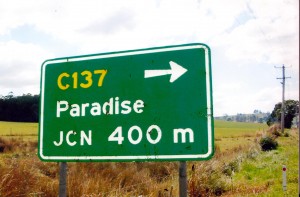THE DEVIL IN TIM – PENELOPE’S TRAVELS IN TASMANIA
Tasmania is the testicle of Australia – suffusing the Mainland with strength and vigour. What a pity there is only one of them…
I have to plead guilty to coining that aphorism. It is not unknown for island people to feel they have special values, unique qualities denied to other unfortunate mortals who have had the misfortune not to be born on the island in question.
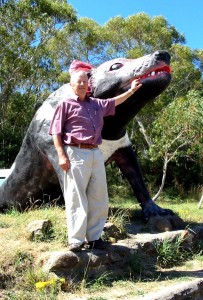
Tim and the Devil near the Trowunna Wild Life Park near Mole Creek on the north-west coast of Tasmania.
It’s a funny thing, but although I haven’t lived in ‘the testicle State’ since 1965, I still tend to identify myself as a Tasmanian, and certainly my passport has not been taken away. I often go back there to visit friends and family (my two brothers and sister still live there) and do occasional speaking engagements and take part seminars on topic various. A lot of expatriate Tasmanians feel the same way.
My old friend Christopher Koch who has written about the Tasmanian landscape more evocatively than any home-grown novelist I could name, once wrote about the surge of excitement that returning Tasmanians feel as they fly over Bass Strait and catch their first glimpse of the island which ‘causes a leap of the heart, like the sudden appearance of a loved face’.
In my youth and early working life as a journalist I travelled widely in Tasmania, bushwalking and covering stories for ABC radio and television (and earlier as a reporter for the Hobart Mercury) but I had never travelled in my native island as a tourist. I wanted to do a Penelope book on Tasmania, but as I was planning to write an autobiography (Spooling Through – An Irreverent Memoir) I was nervous about using personal experiences that might double up with Spooling Through – which was eventually published first in 2004.
That cleared the decks, really, for Penelope and The Manor, Ros and me, to voyage to Tasmania in 2004 to explore my home state for the first time as a visitor. I was able to visit places not seen for thirty or more years, like Cradle Mountain which I first saw in 1948 when, as a ten-year-old my parents and some of their friends rather bravely took me through the Lake St Clair-Cradle Mountain Reserve, an 80 kilometre six-day trek which was perhaps more of a challenge for the adults who had cajole me along, than it was for me.
But it was an experience that stayed with me, and triggered a great love of walking in the Tasmanian bush, even though I nearly died in 1956 when, with two companions, we took a short cut when walking out of Lake Pedder (then still in its pristine state) into the Arve Valley near Geeveston. We missed the track, but unwisely kept going, and three days later emerged cold and starving from the tangled rainforest maze filled with horizontal scrub – which fills up the valleys like a malevolent barbed wire without the spikes – and were very lucky to get out of it. Other bushwalkers have perished in that area. I have been a great believer in sticking to known walking tracks ever since!
So travelling in Tasmania had many resonances for me, not available to visitors who had not been there before. The West Coast has always fascinated me, with its wild terrain, heavy rainfall and history of gold and copper mining as well as harvesting the incomparable slow-growing Huon Pine, first logged by the unfortunate ‘hard case’ convicts sent to Sarah Island in Macquarie Harbour 1822 in to isolate them from the east coast of Tasmania where the large and secure penitentiary at Port Arthur had not yet been built. With convicts outnumbering free settlers in those days, a convict-led insurrection was seen by the authorities as a distinct possibility.
Huon Pine was ideal for boat building, easily worked and completely impervious to the Teredo worm, the bane of wooden ships from time immemorial.
With many other tourists Ros and I were able to take that wonderful boat journey up the Gordon River, with its incomparable reflections, including a tour of Sarah Island where many convict ruins remain, including great logs of Huon Pine used for the slipway to launch boats built by the convicts – still with sweet, fragrant smelling wood still only a few millimetres below its seemingly rotting surface.
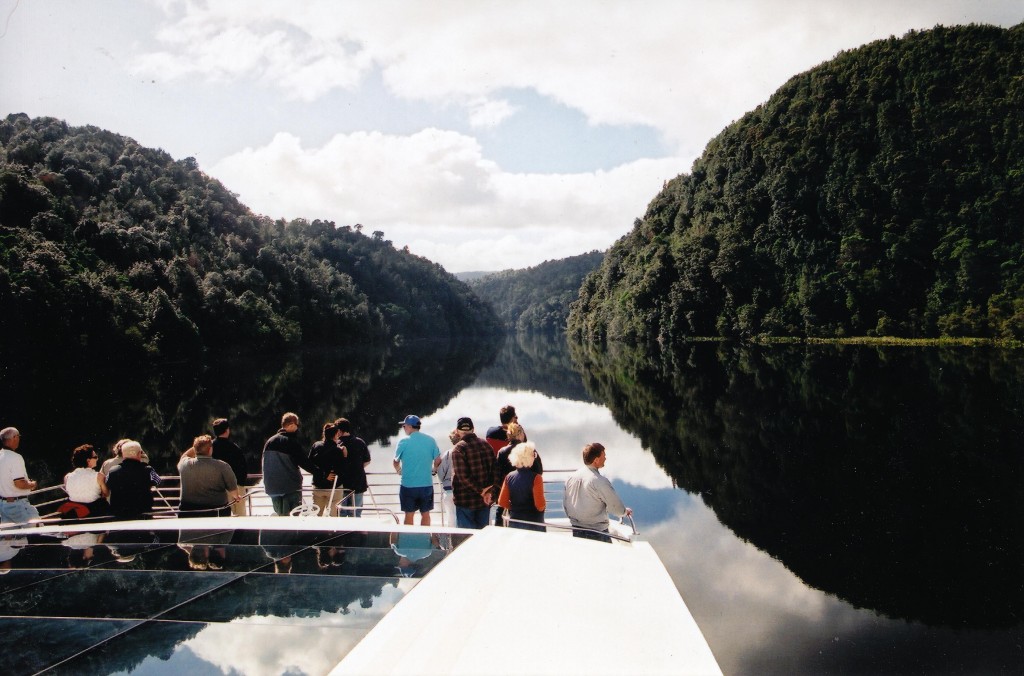
Fellow tourists on the upper deck of the Lady Jane Franklin admire the incomparable reflections on the dark waters of the lower Gordon River during a tour of Macquarie Harbour on the west coast.
In recent times the historic Abt Railway has been rebuilt, using the original steam engines that used an ingenious system of cogs in the middle of the track to haul the ore from the Mt Lyell Company’s mines over an otherwise impossibly steep gradients to reach ships waiting in Macquarie Harbour. It is surely one of the great railway journeys of the world. I got to ride in the engine-driver’s cab too, as we engaged the Abt system. It was a bit nail-biting on this trip, as the little engine was ailing, and only JUST made it to the top of the hill.
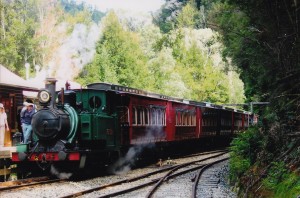
The reconstruction of the historic Abt Railway on the west coast is now enshrined as one of the great railway experiences of the world. Here steam locomotive Abt No 3 (manufactured in the late 19th century) waits at Dubbil Barril Station to begin the 1 in 20 climb up over the King River Gorge, locked on to the sprocketed steel teeth of the unique Abt railway system. Do not miss the chance to travel on the West Coast Wilderness Railway.
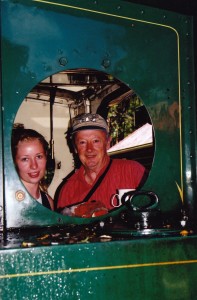
I got to travel in the cab of Abt No 3 steam engine with the driver Mark and his exceedingly attractive ‘fireman’ Caroline.
With my new-found enthusiasm for Aboriginal rock art in the Kimberley, I was aware that the Tasmanian Aborigines had some sites on the West Coast, and I contacted Brian Mansell then manager of the Tasmanian Aboriginal Land Council in Hobart. I thought he might have more important things to do than offer to show them to me, but to my delight he offered to meet us south of the Arthur River for a personally conducted tour.
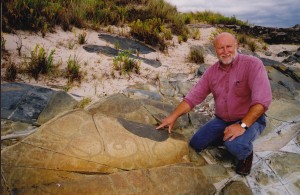
Tasmanian Aboriginal leader Brian Mansell points to where vandals or art thieves have levered away a slab of priceless ancient rock etching at Sundown Point on the west coast of Tasmania. I must have asked him to smile for the camera, because he certainly wasn’t happy about what had happened.
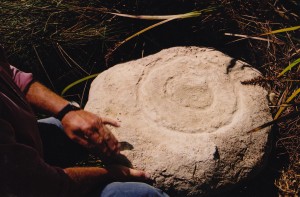
Over thousands of years , rising sea levels have submerged Aboriginal rock carvings. Remarkably in 2002, this deeply etched fragment of sandstone was washed up on the beach at Preminghana, Mt Cameron West, just south of Marrawah and is now in the care of Brian Mansell.
This was one of the highlights of our Tasmanian wanderings, getting to know Brian (who has had a remarkable life) and seeing the rock engravings at a site called Sundown Point and later at Preminghana, further north, near Mt Cameron West near the town of Marrawah. Although rising sea levels have obliterated some of the petroglyphs previously photographed in the early 20th century, Brian was able to show us one remarkable example of concentric circles engraved on a slab of sandstone that had been washed up on the beach at Preminghana!
The person who found it had contacted Brian, then stayed with the stone in case it was stolen. Brian has since hidden the stone at Preminghana and asked us to wait on the beach while he produced it, and allowed us to photograph it.
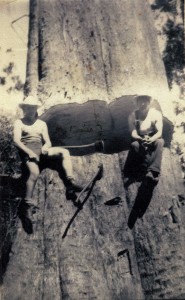
My Uncle ‘Dak’ Diprose (right) is pictured with his mate Les Burr in 1948, in the process of axing a front scarf of a huge mountain ash near Ringarooma, in north eastern Tasmania. The timber was hauled out by bullock team, which I saw working as a youngster at that time.
Often our wanderings became personal. On the north-east coast of Tasmania we called in to Bridport to meet my Aunt Judy Diprose (my mother’s youngest sister) and her husband ‘Dak’.
Dak and Judy met in the north-east. The Diprose family had dairy farms in the Ringarooma area, a small timber and farming town to the south-east of Scottsdale. Judy was a schoolie at the local area secondary school, having not long graduated from teacher’s college. (The Diprose family were heavily addicted to nicknames. Dak – Harold – is not sure why he was called Dak, but none of his siblings used their given names, and were happily known all their lives by short, sharp, pet names like Ink, Budge, Wak and Biz.) The slim, dark-haired schoolteacher and the big, easy-going farmer fell instantly in love and stayed that way for the rest of their lives. Dak, at eighty-two, still carried the muscle and bulk of the timber-getter. I remembered meeting him for the first time when I went to Ringarooma to stay with them during a school holiday. I must have been about ten or eleven, so it was the late 1940s.
At that time bullock teams were still being used to haul hardwood logs out of the forests. As a small boy I was fascinated by this, and Dak took me out into the bush while they were working. The bullocks were yoked in pairs, and the bullock driver controlled them by yelling strange (to my ear) commands, and occasionally flicking individual bullocks in the team with a fearsomely long rawhide whip. The verbals were also sprinkled with a fair amount of profanity, as was the way of bullock drivers wherever they worked. I’d heard worse at school.
One morning Judy came out with me to see the action. But there was a problem. Deprived of his salty language, in deference to Judy’s presence, the driver couldn’t get the bullock team to do anything! They just stood there. Eventually the problem was explained to Judy and she retired to a point where the bullocky could yell at his charges in the way they understood, away from delicate feminine ears. I asked Dak if my memory of that was accurate, and he said it was.
Old Reg Lewis was the driver, and he couldn’t talk to the bullocks in the way they understood while Jude was there.
I asked Dak if the bullocks really needed to be sworn at to understand what they were supposed to do:
You taught the instructions with the whip and they knew. You didn’t use the whip until you had to use it, and that’s where you became a little bit annoyed and the adjectives started to flow. And then the bullocks would react.
I didn’t know it at the time, but I was seeing the last of an era that had begun in the very early days of European settlement in Australia. Dak told me that only a few years after my visit, the bullock teams were replaced by tractors. It won’t be long before living memory of that era will be gone.
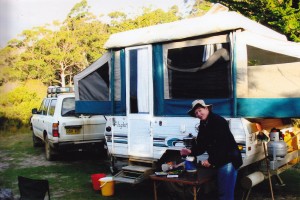
Our most southern camp in Tasmania, at Cockle Creek, only ten kilometres from South-East Cape. Ros is preparing a celebration dinner.
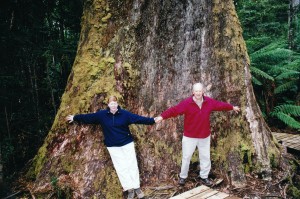
The Bowdens at the base of the 87-metre tall Eucalyptus regnans, appropriately known as ‘The Big Tree’, in the Styx Valley, south-east Tasmania. At the time many of these giants were being felled for woodchips. It was certainly too big for us to hug.
It was quite enchanting to re-discover my home state, with its rich, sometimes dark history, and now emerging as one of the premier gourmet destinations, using much of Tasmania’s home-grown or fish-farmed produce thanks to the island’s cool temperate climate. In the 1950s you were lucky to find a restaurant that was able to offer anything other than grilled steak or chops, mashed potatoes and two (overcooked) servings of vegetables.
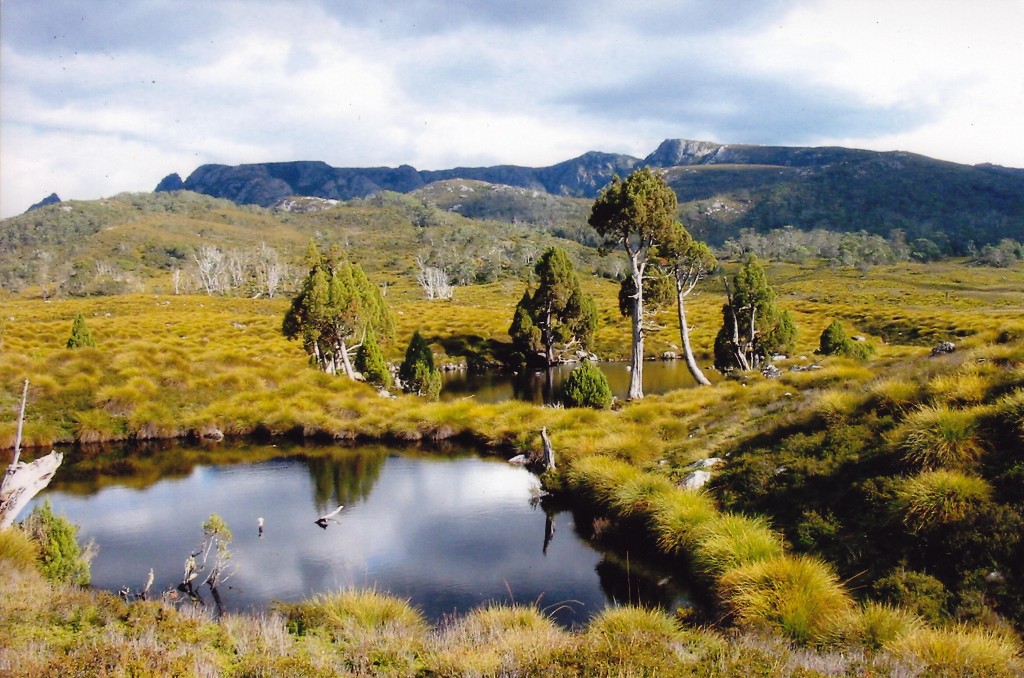
We thought this high country around Cradle Mountain in Tasmania north-west had distinctly Tolkien-style overtones. King Billy pines and tiny tarns are fringed by the ubiquitous cushions of button grass.
After our circumnavigation of the island we headed back to the north-west coast to Devonport to catch the vehicular ferry, one of the two Spirit of Tasmania’s, regularly on the Melbourne-Devonport-Melbourne run. Climbing out of the Meander Valley heading to Devonport and the end of our Tasmanian wanderings, I saw a wondrous road sigh. It said simply:
Where else but in Tasmania could you have access to what you might say was the ultimate destination?
Available to purchase for $36.50 including postage and handling within Australia.
Contact Us to inquire

